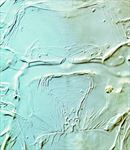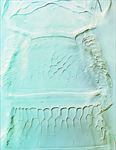
Zaniothrips antenna

Zaniothrips head & pronotum

Zaniothrips meso & metanotum

Zaniothrips tergites I-III

Zaniothrips male tergite IX
Generic diagnosis
Female macropterous. Head wider than long, not strongly reticulate but with broad reticulate posterior collar; ocellar setae I present, II longer than III; three pairs of well-developed postocular setae; maxillary palps 2-segmented. Antennae 8-segmented, segment I without paired dorso-apical setae; III with sense cone forked, IV with one forked and one simple sense cones. Pronotal sculpture weak or absent, anterior margin with one pair prominent setae, posterior margin with one pair of prominent setae, two pairs of long posteroangular setae. Mesonotum entire, transverse, anteromedian campaniform sensilla absent. Metanotum weakly reticulate, triangle present, median setae close to posterior margin; campaniform sensilla present. Fore wing with anterior margin fringe cilia shorter than costa setae; first and second veins with complete rows of long setae; clavus with four veinal setae but no discal setae; posterior margin fringe cilia wavy. Prosternal ferna divided; basantra membranous and without setae; mesosternum endofurca without spinula, metasternal endofurca U-shaped not extending to mesosternum. Legs without reticulation, tarsi 2-segmented. Tergites with entire craspedum, II anterolaterally with closely spaced ridges; I–VIII with crescentic series of large reticles behind antercostal ridge; VIII without comb; IX with anterior pair of campaniform sensilla present; X median split complete. Sternites with entire craspedum; II–VII with three pairs of posteromarginal setae; VII with two additional small setae.
Male sternites without pore plates.
Biological data
The only species placed in Zaniothrips is known to breed only on the leaves of Castor Oil plants, Ricinus communis [Euphorbiaceae].
Distribution data
This genus is known only from India, Thailand and southern China. The host plant is originally native to eastern and northeastern Africa, but the thrips has not yet been recorded from that continent.
Nomenclatural data
Zaniothrips Bhatti, 1967: 6. Type species Zaniothrips ricini Bhatti, 1967, by monotypy.
Only one species is placed in this genus (ThripsWiki, 2020), and this is recorded from southern China:
ricini Bhatti, 1967: 6.
Relationship data
Thripidae sub-family Panchaetothripinae: this group is represented widely around the world, particularly in tropical areas, and comprises about 40 genera. Zaniothrips is particularly unusual in this group because the body colour is whitish-yellow, not dark brown, and the head and pronotum bear long setae. It appears to be related to a group of genera in the Old World tropics that are mainly from Africa (Mound et al., 2001).
References
Mound LA, Marullo R & Trueman JWH (2001) The greenhouse thrips, Heliothrips haemorrhoidalis, and its generic relationships within the sub-family Panchaetothripinae (Thysanoptera; Thripidae). Journal of Insect Systematics and Evolution 32: 1–12.
ThripsWiki (2020) ThripsWiki - providing information on the World's thrips. <http://thrips.info/wiki/Main_Page>